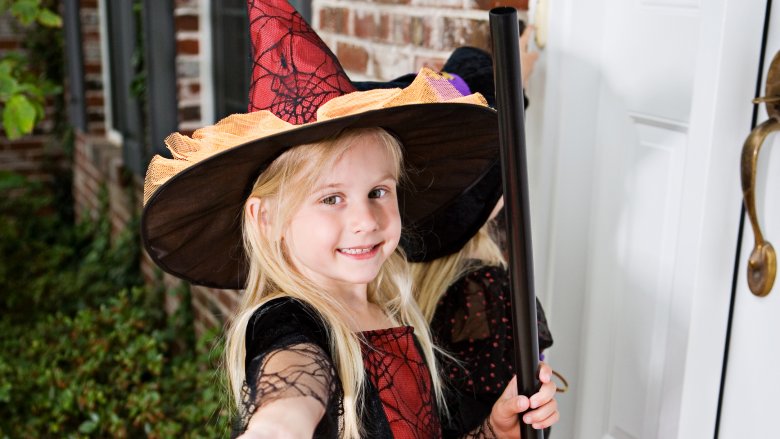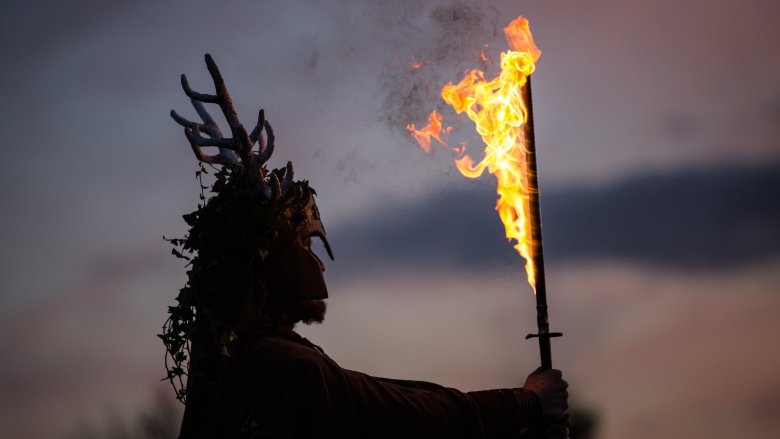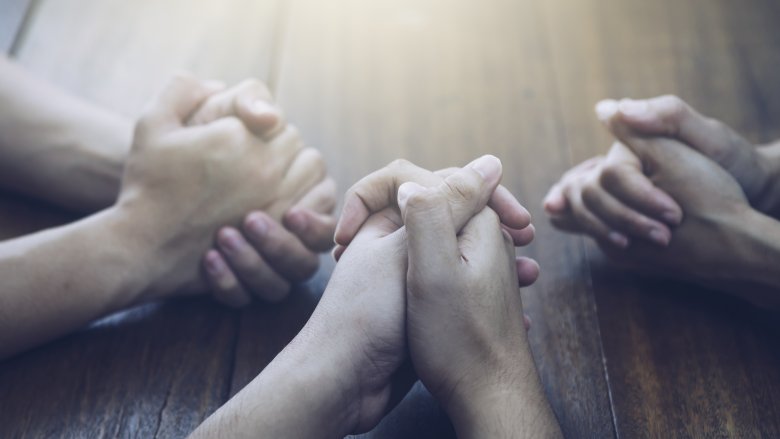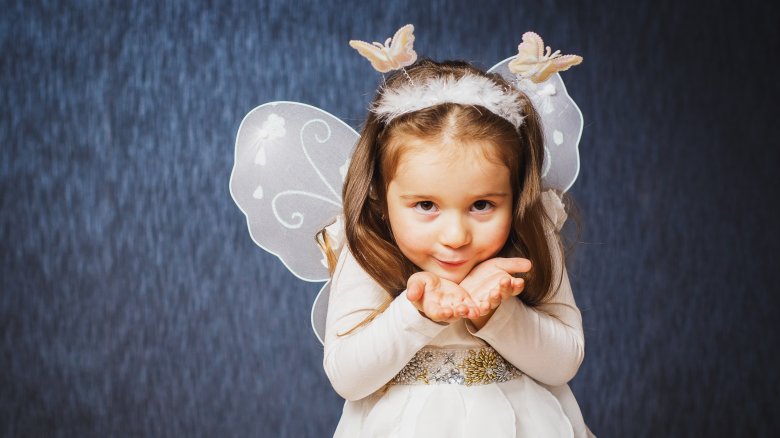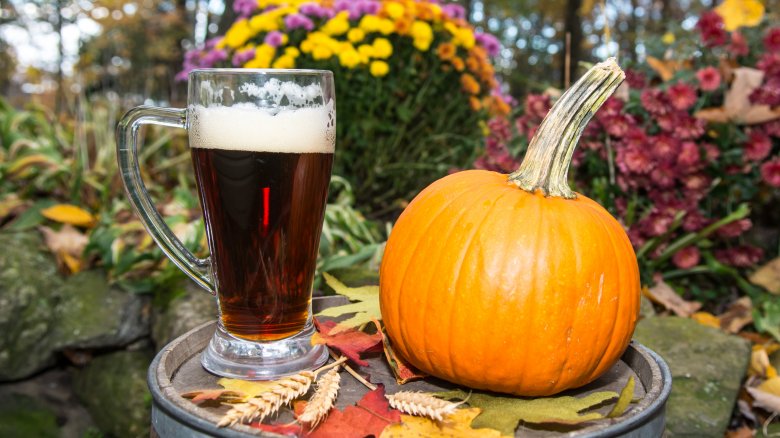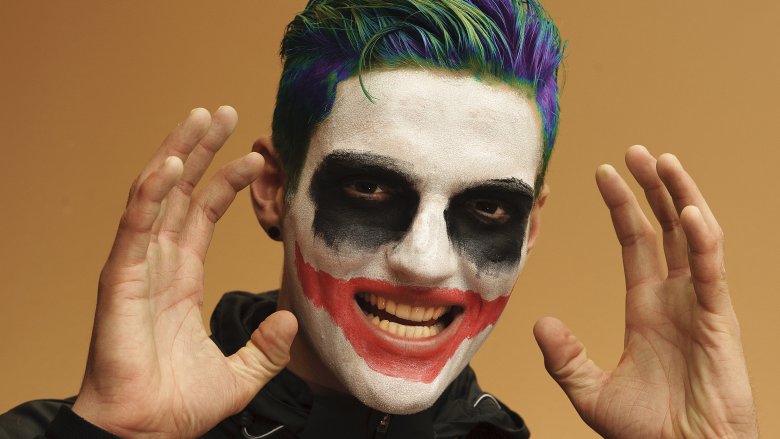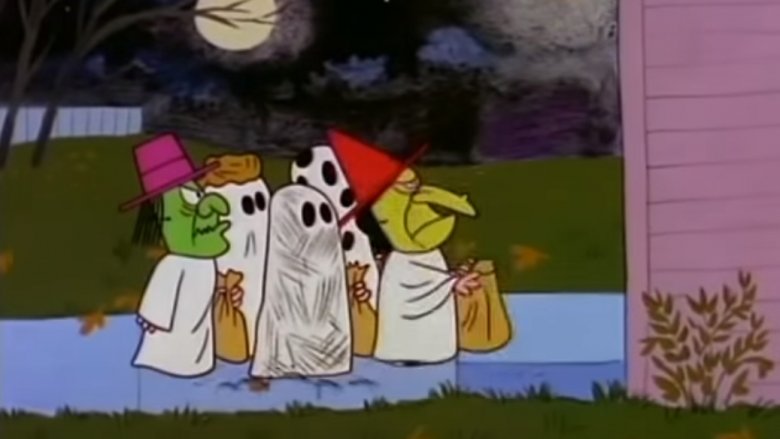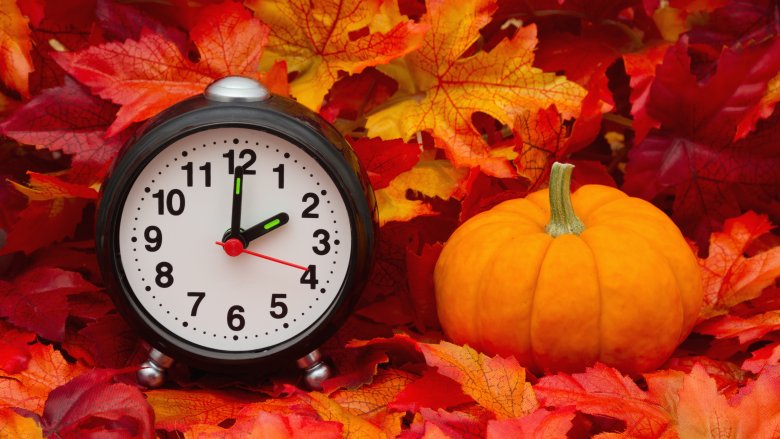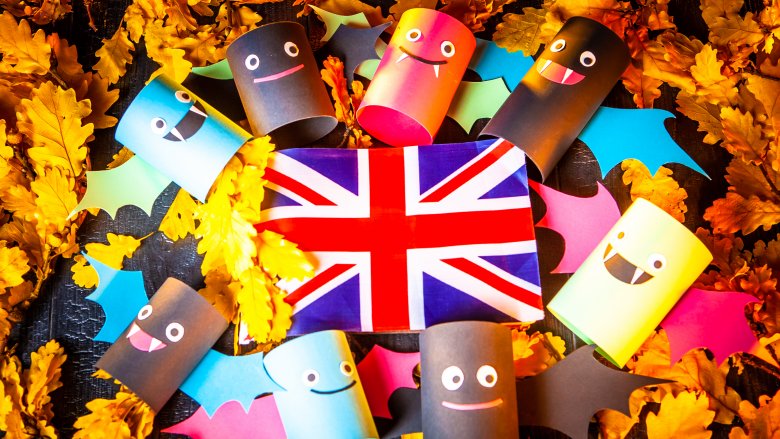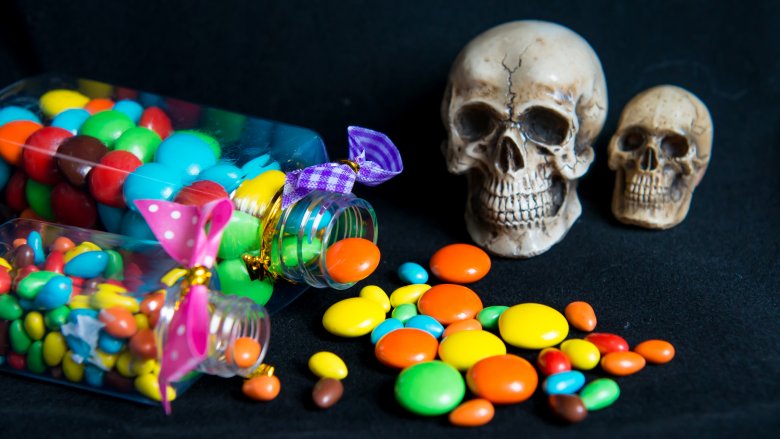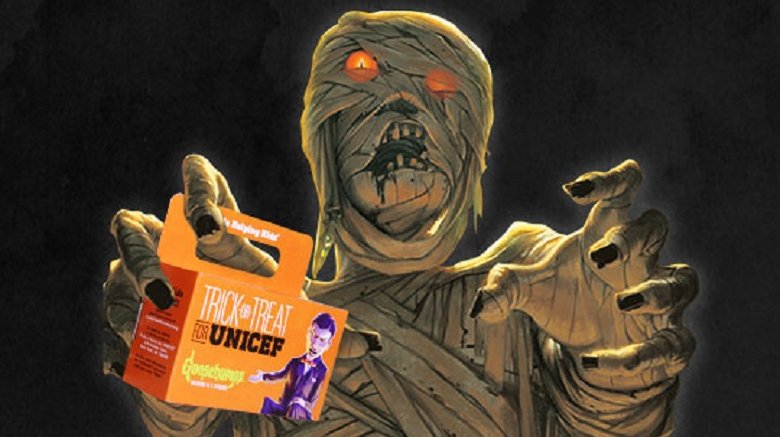The Bizarre History Of Trick Or Treating
Holidays are a lot of fun when you're a kid. On Christmas you get presents. On Thanksgiving you give yourself a turkey coma. But Halloween is the best. Not only do you get to dress up as whatever Pokémon or superhero is in that year, you get to go trick-or-treating and get a pile of candy. Most of the year your parents are telling you to be careful of strangers and not to rot your teeth with all that sugar, but on Halloween all rules are off. They send you to knock on random people's doors and let you stay up eating more sweets than you usually get in months.
But why do children do this? Candy and costumes are an oddly specific way to celebrate a random night of the year. It turns out trick-or-treating has been slowly developing for over 1,000 years, and its history is pretty crazy.
Samhain let dead people go trick-or-treating
Unlike a lot of other secular and religious festivals, whose origins are relatively clear, Halloween seems to have come from all over the place. It makes sense; death is a big part of life and was even more so back before modern medicine and basic hygiene standards. With people dropping like flies all the time, it's logical that almost all cultures had some sort of celebration for them. Eventually, many of them would meld together, and we would have an excuse to eat candy.
But historians seem to agree the most important precursor to modern Halloween was the Celtic festival of Samhain. Starting in ancient times, it was held on November 1. It coincided with the harvest, and villagers would come together to store food and slaughter livestock for the winter. But according to the Encyclopedia Britannica it was also "fraught with danger, charged with fear, and full of supernatural episodes." The Telegraph reports that people believed the wall between the living and the dead became thinner, allowing spirits to pass through. In the hopes of scaring them off, they would dress up like ghosts themselves, making throwing a sheet over your head as a costume historically accurate, if totally uninspired.
So where does the trick-or-treating come in? Well, Redbook Magazine says at that point it was only for dead people. It was thought spirits would return home, and the night before Samhain, October 31, houses left food and wine out for the spirits to make them happy, like zombie Santa Clauses.
On Hallowtide people prayed in exchange for booze
Eventually Christianity spread across Europe, but people didn't want to lose their fun dead-relatives festival. So the Catholic church just made it their own, changing Samhain to All Saint's Day and the night before became Hallowtide. The pope was seemingly fine with everyone still believing spirits were coming back to get them, as long as they also got on board with Jesus.
By the Middle Ages, someone must have realized that leaving all that food out for ghosts was kind of pointless, so poor people got in on the action instead. Time says they would go from house to house on Hallowtide, offering prayers for the family members who had died that year. This was important because Catholics believed that when you kicked the bucket you went to purgatory. One of the ways to get out and start having fun in heaven was for people still on Earth to pray for your soul. The more prayers, the faster you could leave. In exchange for helping out the home's late loved ones, the poor people were given food and beer.
Sometimes they even wore costumes. One historian says those going door-to-door would don "subtle disguising, masks, and mummeries." A particular favorite for choir boys was to dress up as virgin brides. This cross-dressing was supposed to represent all the marriages that would happen in the next year, which meant lots of babies, and therefore the important replenishment of the Christian population.
Children finally took over in some places
The process of going house-to-house to help save dead people's souls was given the very original name "souling." In a lot of places, it was something mostly adults did, but eventually in areas like Scotland and Ireland it became an affair for children and they changed the name to "guising." The kids would dress up in costumes and start wandering around the neighborhood.
So far, early trick-or-treating had been all about the treat part of the equation. You came to a house, whether you were alive or dead, and were given food and drink. But according to History, guising involved a "trick." The children no longer offered to pray for souls, possibly because adults realized they were just doing it for the food. Instead, they put on a little performance for the person who answered the door. That was the "trick"; it didn't yet involve an overt threat of blackmail.
The children would show off a bit, by singing a little song, telling a joke, or reciting a poem. This was probably more exciting for the homeowner than it sounds because, remember, they didn't have Netflix back then. In exchange for this entertainment the kids would get some fruit, nuts, or coins.
Guising was limited to the old Celtic areas, though, while most places kept up souling.
Immigrants brought it to America and added partying
In 1517, coincidentally on October 31, Martin Luther published his 95 theses and accidentally started the Protestant Reformation. Soon, Catholicism was out across huge swathes of Europe, and the new pope-less religion was in. One of the random side effects of this was that Hallowtide and souling fell out of fashion. There was no need to say prayers for loved ones to get out of purgatory anymore, since Protestants didn't believe purgatory existed.
But some people in the remaining Catholic areas kept up with souling. According to Time, hundreds of years later, starting in the 1840s, many of those Catholics would leave the old country behind and come to America. They did not, however, leave behind their customs. Souling took on a new look. Young people would dance around outside tenement buildings and other folks would give them gifts in exchange. Everyone would make costumes out of old clothes and paint their faces using burnt corks. Naughty tricks finally emerged, stuff you probably shouldn't try today like sticking cabbages up chimneys or hitting each other with bags of flour. And everyone would get really drunk and party in the streets and bars all night.
Protestant Americans who had been in the country longer did not like this new wave of immigrants or their Catholicism one bit. But everyone likes partying and getting presents. So they took the holiday, made it completely secular, and ran with it. Within decades Halloween was hugely popular in the U.S.
Halloween suddenly turned violent
In the late 1800s and early 1900s, Halloween in America was considered an event for teenagers and college students, according to Time. At that point it mostly involved throwing parties. But by the 1920s, these young people had decided pranks were a lot more fun than apple bobbing.
We're not talking innocent japes here. History says property damage each year in major metropolitan areas could come to more than $100,000. Then the Great Depression just made it worse. At that point, teenage Halloween mischief involved "vandalism, physical assaults, and sporadic acts of violence." Obviously, something had to be done to nip this in the bud.
It may have been a reaction to this mayhem that led to community-based trick-or-treating efforts in the 1930s. This was the real start of the tradition we know today: children dressed in costumes going door-to-door asking for candy. It's also when the phrase "trick-or-treating" first appeared in print. The Phrase Finder reports the earliest known citation was in the Oregon Journal on November 1, 1934, when readers learned how children had "successfully worked the 'trick or treat' system in all parts of the city" the night before. However, it was apparently still a controversial activity since they also called it a "shakedown." Lots of other newspapers started covering trick-or-treating in the next few years, many also despairing at the practice. In 1938, one reported that numerous homeowners across the nation had shot at children who dared ask for candy.
World War II threw a wrench in everyone's fun
Just as people were finally getting used to this new tradition and it looked like it was going to catch on, World War II started. According to America in WWII, this meant sugar was suddenly rationed, and candy was hard to get.
Some kids would still try, and people would give them what they could, with new traditions thrown in. One woman who was a child at the time remembered often being invited inside homes to talk to the parents of soldier who were off fighting. But some adults tried to guilt trip kids out of having any fun at all. One school superintendent wrote that even ringing doorbells that late was unacceptable because it might be "disturbing the sleep of a tired war worker who needs his rest." And you better not have thought of pulling a prank like soaping windows — the government needed soap and grease for the war effort.
It wasn't just candy-related fun that was curtailed. Community events like parades were canceled to save on resources. Chicago went so far as to "abolish" Halloween completely for the duration of the conflict.
After the war ended, everyone went right back to trick-or-treating. As suburbia exploded, so did the tradition. History says candy companies quickly targeted Halloween, and by 1951 it was solidified in pop culture when the Peanuts kids went trick-or-treating in a comic strip. Donald Duck took his nephews in a Disney cartoon a year later.
Daylight saving time got extended partially so kids had more time to get candy
There's an urban legend that the reason we now turn the clocks back in November rather than October is thanks to candy companies, who wanted the extra hour of light so kids could trick-or-treat for longer. Except, according to NPR, it's no legend. It's totally true.
Congress finally voted to move the end of daylight saving time from just before Halloween to just after it in 2005. By that point, candy companies had been lobbying hard for the change for 25 years. It makes sense. Millions of kids asking for candy for an extra hour means houses have to buy more, which means those companies are in the money — as if the $2.2 billion spent on candy every year isn't enough.
When Congress first debated the change back in 1985, candy companies allegedly left a candy pumpkin on the seat of every senator to remind them to vote the right way. (Redbook Magazine says some in the industry have since denied doing this.) Of course, it sounds bad if you say you voted to change DST because you once got bribed with a candy pumpkin, so the official reasons given are things like "energy conservation." But the fact of the matter is, if Halloween was in September, the change probably would have never happened.
Trick-or-treating is now worldwide but not popular everywhere
In the last 70 years, Americans have moved all over the world taking trick-or-treating with them, and of course anyone who watches American media is familiar with it as well, so it has spread around the globe. But not everyone likes it. The British, in particular, seem to hate trick-or-treating.
According to Today I Found Out, trick-or-treating only started in the U.K. in the 1980s, and even then, it took a long time to catch on at all. So people there don't have the nostalgic connection Americans do. It was originally viewed with much suspicion. The BBC reports that in 1986 this controversial new practice was even debated in the upper house of Parliament, where it was described as "demanding money on threat of playing a nasty trick, now being used by youths to obtain money from old people," so either they didn't understand it or British kids were doing it wrong.
As recently as 2006, a survey found 58 percent of homeowners in Britain turned off their lights and pretended not to be in on Halloween. One respondent went further, saying of trick-or-treaters, "I've thought about removing the cover from my doorbell so they electrocute themselves." A journalist called it a totally unwelcome import and said it was simply an "irritating excuse to annoy the neighbors," which had "hijacked" an ancient festival. He's just one of many there who is really not a fan.
The poisoned candy legend has a dark history
When you were a kid you probably heard warnings that there were sick people out there who were poisoning Halloween candy before handing it out to children. In actuality, this has never been a problem. According to Snopes, the urban legend had already been around for a while before two mostly unrelated incidents in the 1970s seared it into the public mind.
Five-year-old Kevin Toston fell into a coma on November 2, 1970, and died four days later. An analysis of his Halloween candy found it had been sprinkled with heroin. Newspapers screamed this was an example of a twisted person trying to kill trick-or-treaters. What didn't get as many headlines was the police's eventual conclusion that Kevin had found his uncle's heroin stash and eaten most of it. To avoid getting the uncle in trouble, the family put the drug on the candy.
But the most infamous poisoned Halloween candy death was in 1974. Eight-year-old Timothy O'Bryan died after eating a Pixie Stix filled with cyanide that he had allegedly gotten while trick-or-treating. In reality, his father, Ronald, had filled it with the poison and given it to him, possibly because he wanted to collect on his son's large life insurance policy. Ronald was convicted and executed in 1984, but not on Halloween as is often claimed.
Many other poisonings have been linked to Halloween candy, but after the hysteria dies down virtually all of them prove to be from something else.
Those UNICEF boxes have been around a long time and are incredibly successful
When you were a kid you might not just have been looking for candy when you went trick-or-treating. Millions of kids also bring little orange boxes with them and ask people for spare change. That UNICEF program has an interesting history of its own.
According to UNICEF's website, it wasn't some professional bureaucrats at the U.N. who came up with Trick-or-Treat for UNICEF. Instead, it was five thoughtful children in Philadelphia in 1950. They had seen on the news that kids in Europe were still really suffering after World War II. So as they went door-to-door that year, they asked for money to help those suffering. They raised $17 and decided to donate it to the United Nations Children's Fund. UNICEF was so inspired by their actions that they made it an official program the very next year, and every year since more children have participated. There's even a competition between schools to see who can raise the most money. Celebrities get involved to increase awareness, with some of them even talking about how they remember asking for money for UNICEF when they trick-or-treated as kids.
The program is now in other countries as well, and Today I Found Out says it had raised $167 million by 2012. Those orange boxes became synonymous with Halloween so quickly that in 1967 President Johnson declared October 31 to be "UNICEF Day."
